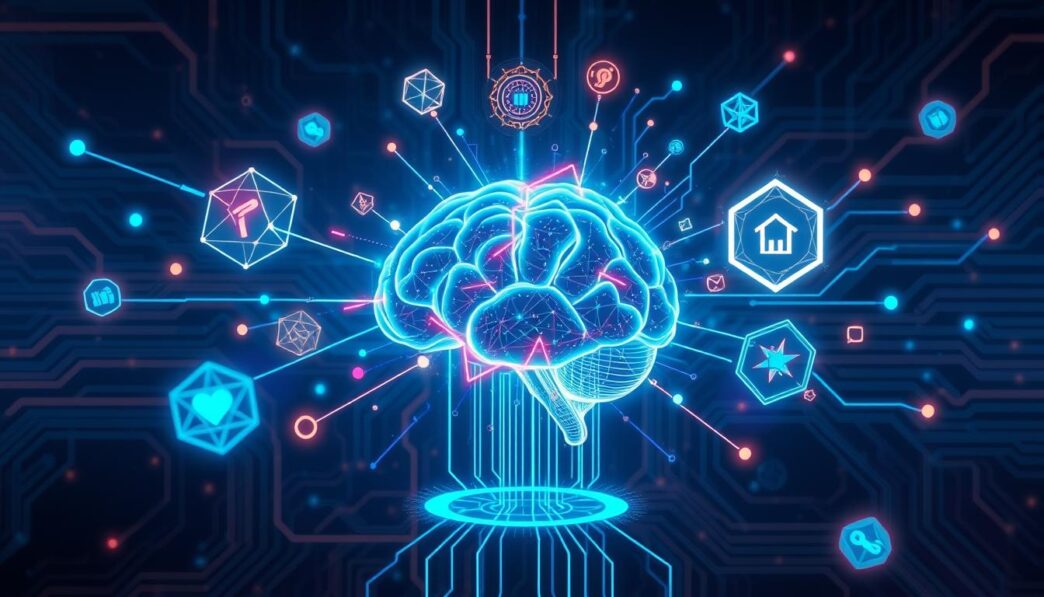The world of AI is changing fast, and GPT-4 by OpenAI is at the front of it. This language model can understand and process words better than ever. It lets us pull out and use complex information easily.
GPT-4 can look at 8000 bits of information at once, making apps smarter in many fields1. It helps make summaries better and deal with complicated questions. For developers, it’s a game-changer2.
But remember, GPT-4 has its limits. Sometimes, even after hard work, it might not get everything right. This shows that we might need to wait for newer versions or other tools for some goals3.
Looking into how to use GPT-4 for pulling out data can really help your projects stand out.
Key Takeaways
- The vast context processing ability of GPT-4 enhances app development opportunities1.
- Refined summarization processes are integral to the full utilization of GPT-4’s abilities2.
- Understanding the current limitations of GPT-4 is essential for setting realistic extraction goals3.
- Future AI models may offer improvements in areas where GPT-4’s performance is lacking3.
- A strategic approach to concept extraction should include state-of-the-art tools and techniques231.
- Successful application of GPT-4 requires patience and an openness to collaboration and knowledge sharing2.
Decoding the Essentials of GPT-4 Concept Extraction
GPT-4 has made big steps forward from earlier versions. These improvements come from better neural network designs and training methods. OpenAI’s GPT-4 shows how using scalable sparse autoencoders is key to better AI concept spot.
Thanks to changes in its design, GPT-4 can do many complex tasks now. It works with more GPT-4 features4 to make sure concepts pulled from data are correct and useful to the user.
GPT-4’s special neural system helps it sort through ideas clearly. This is a big step up in OpenAI’s technology4.
The way GPT-4 uses the back propagation algorithm is finely adjusted. This adjustment allows millions of tweaks in the neural networks. These tweaks make the concept finding in GPT-4 better4.
These improvements use advanced encoding and a layered approach. This fits with the newest deep learning trends4. GPT-4 not only gets data details but also gives insights that make sense, setting it apart from older models a lot.
OpenAI keeps working to make these models better and easier to use. Making GPT-4 a key part in AI concept finding’s growth.
The Pioneering Multimodal Abilities of GPT-4
The launch of GPT-4 has brought big changes to AI, particularly in how it handles different types of data. GPT-4 is unique because it goes beyond text. It can understand and create images, audio, and videos too.
Comparing GPT-3.5 and GPT-4’s Reasoning Capabilities
GPT-4 has made huge jumps forward from GPT-3.5, especially in making sense of data. It’s especially good at working with more than just words. Paul Wang’s research shows GPT-4 can neatly put info into tables and graphs. This shows it’s smarter than GPT-3.55.
GPT-4Vision: Image Processing with GPT-4

GPT-4 has started a new chapter in AI with its GPT-4Vision. With its ability to understand pictures, it can describe them in detail. Researchers say this model excels at turning messy data into clear, organized info6.
When it comes to making content, GPT-4 can mix pictures with words in amazing ways. This is important for learning. It helps make and understand complex topics better. Learn more about GPT-4’s image processing6.
| Feature | GPT-3.5 | GPT-4 |
|---|---|---|
| Text Processing | Advanced | Highly Advanced |
| Reasoning Capabilities | Limited to Text | Extensive across Modalities |
| Image Processing | Not Available | Available via GPT-4Vision |
| Data Accuracy | Competent | Significantly Enhanced |
GPT-4 multimodal capabilities are changing the game. They’re making AI more integrated into our online lives. This moves us towards a future where AI plays a bigger role.
Practical Guide: How to Extract Information from PDFs using GPT-4
In today’s world, using GPT-4 to get data from PDFs has changed the game. We now can turn complex files into easy text quickly. This part talks about using GPT-4 to pull data from PDFs. It covers how to get ready and how to ask GPT-4 the right questions.
Preparing Your Document for Extraction
Starting the PDF to text AI process with GPT-4 takes some prep work. First, we need to make documents AI-ready. This might mean turning PDF pages into JPEGs to help with extracting data, even from pictures7.
After changing the format, using Machine Learning for text recognition is key8. Make sure your document is set up right for GPT-4. This helps avoid losing or messing up data.
Crafting Effective Prompts for Data Retrieval
When using GPT-4 to get data, asking the right questions is very important. Questions like “Extract all headings” or “Summarize page five” tell GPT-4 exactly what to do. This makes the process quicker and the results better.
Prompts can also ask to change text data into structured formats. This makes it easier to use this data with other tools7. Using prompts well helps GPT-4 work better, giving you the info you need.
| Feature | Description | Benefits |
|---|---|---|
| Text Recognition | Uses ML for accurate text extraction from any PDF structure. | High accuracy and adaptability to varying document layouts8. |
| PDF to JPEG Conversion | Prepares PDFs for graphical data extraction. | Enables comprehensive data retrieval including images and graphics7. |
| Custom Prompting | Allows specific data extraction via structured prompts. | Streamlines the process, ensuring data is relevant and precise7. |
Using these high-tech methods boosts GPT-4’s data pulling power. It also speeds up how businesses and researchers turn lots of PDF data into useful insights. With clear prompts and the right prep, this process becomes a powerful tool for dealing with today’s data needs.
Automating PDF Data Extraction with GPT-4 Workflows
Businesses are changing how they handle documents by adding GPT-4 workflow automation to their PDF data extraction. This union of ChatGPT and cutting-edge IPaaS tools boosts how work gets done. It makes everything much more efficient.

Thanks to AI solutions like Odin AI, data extraction time has dropped sharply. What used to take 5 minutes per page now takes only 5 seconds. These advanced AI algorithms get things right 98% of the time9. This speeds up the job and cuts down mistakes.
Automated workflows quickly upload and process loads of PDFs in just 2 minutes. That’s a big change from the 30 minutes it used to take to sort and categorize manually9. AI goes further by providing quick, short document summaries, saving time on reading9.
Key to this new system is hooking up documents to places like Dropbox seamlessly. Through ChatGPT, documents become organized data in Google Sheets. This makes managing and analyzing data simpler. The system can also notify team members with an email or Slack message instantly when tasks are done.
This tech isn’t just about making work easier. It also leads to handling data better, with greater accuracy and less effort9. As businesses keep using automated data extraction, they see a real possibility for scalable, mistake-free data handling.
Here’s a real-life example: a maintenance contractor with a monthly load of 200 PDF work orders from clients. They come in up to 6 different layouts. AI workflows process them in a consistent way, easing the burden and making info flow smoother10. Time is saved, and things run more smoothly.
The use of GPT-4 workflow automation in data extraction marks a big step forward. It’s not just a passing trend but a deep change. It’s about making information handling and processing both efficient and precise.
Addressing Extraction Accuracy and Consistency in GPT-4
In exploring large language models like GPT-4, we see the need for careful data extraction and AI bug finding. Events have highlighted errors in AI’s results, making quality checks more important. We aim to make GPT-4 reliable and clear in the information it offers.
Quality Checking and Bug Identification in Large Language Models
Efforts to achieve high accuracy with GPT-4 show its consistent ratings, ranging from 0.94 to 0.9911. This means GPT-4 is reliably consistent in its evaluations across different tests. The link between the AI’s style and content quality is notably strong, with a correlation of 0.8711. These numbers highlight GPT-4’s skill in maintaining content quality, even if the style isn’t perfect. Such separation helps in finding and fixing AI mistakes, which is key to keeping our trust in AI technologies11.
Managing Varying Responses and Keeping Data Coherent
For business use of GPT-4, it’s vital to handle response changes and keep information consistent. Knowing how GPT-4 reacts to different prompts is important. A study, available here, showed GPT-4’s stable ratings despite task or feedback changes12. This shows GPT-4 can make dependable choices in similar situations. Its ability to handle new questions while ensuring text consistency is crucial for its business potential11.




















